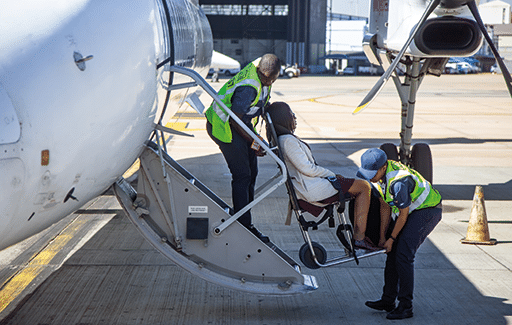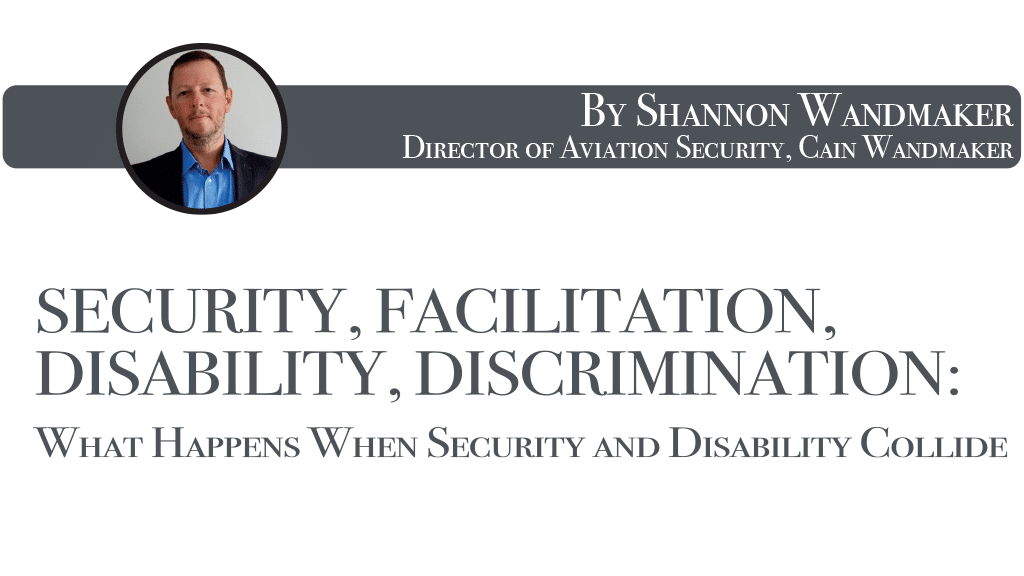One Friday afternoon a man passed through Adelaide airport on his way home after a business trip. The man, who was blind from birth, was traveling with his guide dog.
At the airport security screening point — it is alleged — the man was rudely refused access to the body scanner, and was told to proceed through the walk-through metal detector, with his guide dog put through separately. He was then asked to submit to a pat-down search, though a colleague traveling with him questioned why it was required, as only his dog’s metal harness had triggered the alarm. A screening supervisor who was called over after the fact later agreed that only the dog needed the pat-down search.
The man stated later to the media that he felt humiliated and distressed by not being allowed to proceed through the body scanner and by his subsequent treatment, though by his own account he acknowledged it wasn’t the worst discrimination he’d ever faced.
However, it was, he noted, part of a pattern of discrimination he’d faced time and again when traveling through airport security screening points, which had included being physically pushed back through a body scanner by a screening officer and being on the receiving end of multiple disrespectful and negative comments.
Adelaide airport apologized for the incident. It was not in keeping with their expected high standards of customer service. Indeed, as they pointed out, the airport has a range of policies and programs in place to assist people with disabilities, including having a Guide Dogs trained dog based at the terminal to support travelers who needed extra assistance navigating the terminal.
The problem for Adelaide airport was that the businessman was Graeme Innes, the former Australian disability discrimination commissioner, former Australian human rights commissioner, and a member of the Order of Australia. He knew a thing or two about discrimination.
The problem for Mr. Innes was that the screening officers did nothing wrong. Apart from perhaps displaying less than optimal customer service skills, they were adhering to their standard operating procedures, which in turn had been derived from the legal requirements for screening in Australia.
And so, in a situation where the airport has systems in place to do the right thing, the screening officers involved were doing the right thing, and the passenger themselves was well traveled and well informed, how could it go so wrong, and why does it go so wrong so often?
The intersection between aviation security and facilitation is always a challenging one, and the balance between the smooth flow of passengers and the delivery of aviation security outcomes can be hard to achieve even when facilitating the movement of ‘able-bodied’ passengers from curbside to the aircraft.
So, what happens when passengers with disabilities (physical, psychological, obvious and hidden) arrive in this space?
There are no shortages of examples around the world of people with disabilities receiving less than optimal service at screening points. The inappropriate handling of passengers in wheelchairs, separation of people from their assistance animals, and subjecting people with sensory issues to physical searches being among the more commonly raised complaints.
Given around 20 percent of people have some form of disability, and given the often minimal training security screeners are given regarding the facilitation of passengers with a disability, what can screening providers and airports do to better meet the needs of this substantial slice of the traveling public?
Screening points are, at their core, not designed to accommodate difference, but are designed based on the somewhat shaky assumption that, give or take some height and weight differences, everyone who turns up at a screening point is basically the same, understands what is required of them, can prepare themselves unaided, and can ambulate unassisted through the screening process.
For the 45-year-old CEO who flies eight times a month, this is correct. But what about the retired 75-year-old who has never flown before? Even as an ‘abled-bodied’ passenger, his ability to navigate the screening process as an inexperienced passenger is not the same as the CEO.
Add in some other people: a father traveling with two young children, a tourist who doesn’t speak the language, a person traveling with the cremated remains of a loved one, a group of semi-intoxicated people on a rugby trip. All of these people present differently at a screening point, will have vastly different understandings of what is required of them, and vastly different capacities to comply.
Now, let’s mix in ‘obvious’ disabilities such as deafness or blindness, and people using wheelchairs or mobility aids who need additional time or help through the process. This adds an additional layer of complexity.
But we also need to consider that of the estimated 20 percent of travelers who have some form of disability, between 80 to 90 percent of them will have what is considered an invisible or hidden disability. This will include, amongst others, multiple sclerosis, autism, attention deficit hyperactivity disorder, arthritis, brain injuries, bleeding disorders, mental illnesses, respiratory conditions, speech impairments, diabetes, epilepsy, anxiety, cognitive and learning disabilities, chronic pain, and fatigue.
It turns out people who turn up at screening points really aren’t the same at all.
On the screener side, then, there must be some sympathy.
The expectation that a screening officer, whose primary role is to ensure no threat to security makes it to the aircraft, is also going to have an encyclopaedic knowledge of every disability they may encounter, is unrealistic at best.
In addition, screeners also spend much of their poorly paid shift getting yelled at by people who didn’t know they can’t take a full water bottle through the screening point because the rule has only been in place for 15 years.
It’s probably also busy, and noisy, and the screening point is cramped, and three screeners are off sick, and staff turnover is 35 percent a year so most of the screeners are new.
And while there are some screening organizations that prioritize customer service and the passenger experience, the vast majority of screeners are focused on their primary task — protecting the aircraft from threats — and the customer experience is a secondary consideration.
Any wonder that occasionally a screener’s interpersonal and engagement skills with a person with a disability might not be the same as a Singapore Airlines first class cabin manager.
So, What’s the Solution?
While answers may come from a variety of sources, three key areas will be training, passenger differentiation and technology.
While better training of security staff is important, it’s unreasonable to expect screening officers to know every disability and how to address them. However, there are schemes in place in airports around the world that seek to give the airport community — not just the screeners — simple tools that help staff and a passenger with a disability to interact with each other in a more compassionate and understanding way.
The Hidden Disabilities Sunflower scheme, that finds its roots at Gatwick Airport and is now seen at airports and other transport hubs around the world, is a good example where, by displaying a small sunflower badge, passengers can discreetly indicate they have an invisible disability and may need some support, assistance or simply a little more time when moving through the airport.
The badge forewarns airport staff, and basic training gives them the skills to engage in an appropriate manner.
Having already identified that not everyone who presents at a screening point is the same, the next natural step is to differentiate people in sensible ways.
The simplest first step — space and resources permitting — is the implementation of a dedicated lane for people who need more time. This can include parents with prams, the elderly, people with mobility issues, blind or hearing-impaired people, or people who choose to self-select as needing more assistance.
Taking these people out of the main flow of screening has the dual effect of making other screening lanes more efficient, while at the same time taking pressure off those people who need more time so they don’t feel like they’re holding up the queue.
In addition, further passenger differentiation can be achieved using either real-time or advanced data techniques.
Real-time behavior-based differentiation, which involves a behavior detection officer differentiating passengers before screening, or technology-based differentiation such as automated behavior detection technologies and automated questioning at check-in kiosks, allows passengers considered to be higher risk to be identified and subjected to additional screening.
These techniques could also incorporate an element that would allow people to either self-select as needing assistance (in the case of check-in kiosks), or allow a behavior detection officer or other queue comber to direct people with disabilities to the appropriate screening lane.
Registered or trusted traveler programs such as the TSA Pre-Check system, in which a passenger provides data in advance that allows them to access expedited screening, could also incorporate disability information to give people access to a dedicated screening lane.
Technology will be part of the solution too, but it can be a double-edged sword.
In the Adelaide example, the implementation of body scanners has created categories of passengers who are excluded from their use. This has happened before. People with pacemakers are unable to use a walk-through metal detector, and people with prosthetic limbs almost always find themselves subject to a secondary search, for example.
In addition, most facilitation technology being implemented at airports is focused on removing face-to-face interaction. Online check-in, automatic baggage drop, passport e-gates and the introduction of new screening technology is all well and good for the seasoned traveler, but the opposite of what a person with a disability might require.

The opportunity to tell an actual person, “I need a little more time, I’m having difficulty navigating this process, I’m becoming overwhelmed,” is not built into an automated system.
Seamless travel, automation and digitization can also isolate the elderly, people with learning challenges, and people from lower socio-economic backgrounds who have challenges accessing and interpreting technology.
Being able to go from curbside to aircraft without interacting with anyone is efficient if you’re willing, able, and know what you’re doing, but terrible if you need additional assistance.
If increased automation allows people to pass through the airport more smoothly and at a faster rate, it must also free up airport, airline, screening and immigration staff to be available to provide additional assistance to those who need it. More automation used as a tool to reduce staff numbers and human resource costs is not a recipe for better disability facilitation.
Unfortunately, in the short- to medium-term the situation will likely get worse before it gets better.
In the post-COVID aviation environment, staff shortages are resulting in significantly fewer staff, long queues, frustrated and angry passengers (and staff), and an overall less pleasant airport environment. Furthermore, those staff who are at work are generally newer and less experienced than those staff who were on-the-job pre-COVID. It will take years for staff numbers, and staff experience, to return.
In addition, as the aviation industry recovers from its unprecedented financial losses, investing in new technology is unlikely to be a priority in the near-term.
However, there is light at the end of the tunnel as, long term, accessibility continues to be an industry focus.
In August 2022, the International Civil Aviation Organization (ICAO) elevated from a recommendation to a standard the requirement that States ensure persons with disabilities receive the same services customarily available to the general public, and in September, Airports Council International (ACI) launched its Accessibility Enhancement Accreditation Program, the first global program dedicated to enhancing the accessibility of airports for passengers with disabilities.
Given that around 20 percent of passengers travel with a disability, it is incumbent upon industry to be responsive to the needs of this significant slice of the customer base.
As former Disability Discrimination Commissioner Mr Innes noted after his experience, “I do not want a separate system. (I) want this one to treat us equally.”
That seems like a reasonable request.
